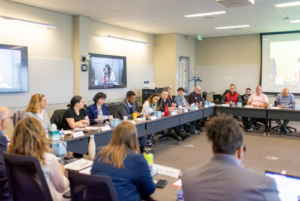 The final President’s Cabinet meeting of the 2022-23 academic year began with a conversation on the new Student Success Launch initiative focused on student retention and recruitment. President Janine Davidson, Ph.D., has charged Interim Provost Marie Mora, Ph.D., and Will Simpkins, Ed.D., vice president for Student Affairs, with leading this data-driven, Universitywide effort, which will include elevating faculty and staff voices in strategy conversations while also centering student voices in identifying barriers to success.
The final President’s Cabinet meeting of the 2022-23 academic year began with a conversation on the new Student Success Launch initiative focused on student retention and recruitment. President Janine Davidson, Ph.D., has charged Interim Provost Marie Mora, Ph.D., and Will Simpkins, Ed.D., vice president for Student Affairs, with leading this data-driven, Universitywide effort, which will include elevating faculty and staff voices in strategy conversations while also centering student voices in identifying barriers to success.

“We are looking at issues related to faculty and staff workload, advising, curriculum and other areas that will bend the retention curve,” Davidson said. “This is part of a reinvigorated, data-driven focus on student success, which will help us operationalize Strategic Plan Pillars 1 and 2, with synergies for Pillars 3, 4 and 5.”
- Next steps for the initiative include:
- Board of Trustees presentation
- Summer deep dives
- Forming a student-success launch task force to align with the great work underway in the Faculty Workload Taskforce
- Creating opportunities to engage everyone in retention strategies
Davidson also provided an update on the Auraria Higher Education Center’s hosting of migrant-processing operations in the 5th Street Garage in collaboration with the City and County of Denver. Davidson commended the care and compassion of AHEC, the Auraria Campus Police Department and the MSU Denver facility team, recognizing them for going above and beyond to provide migrants being temporarily processed with shelter and sustenance. The City and County of Denver Office of Emergency Management is now leading the processing efforts, and all activities have moved off-site. Davidson thanked the campus community for its understanding and concern and noted that OEM officials specifically asked AHEC to share minimal details on the operation to ensure migrants’ safety and privacy.
In recognizing the May winners of the Roadrunner Shoutout Award, Davidson also took a moment to thank Sean Petranovich, Ph.D., director of data and analytics, who is leaving the University this month.
“(The University) would not be where we are today without the work that Sean has done. In the last few years, he has professionalized our enterprise and … brought us to a place where we can identify our pain points and our inflection points and really put us in a position to take the next step,” Davidson said, adding that Petranovich will be greatly missed.
Internal-communications assessment highlights retention, engagement opportunities
Andrea Smith, associate vice president of Strategic Communications, presented an overview of the University’s recent communications assessment, which aimed to better understand the current state of campus communications and how to improve communication to support student retention and employee engagement.
Student-communication analysis findings
Overall, students have an extremely high level of knowledge and trust when it comes to information shared by MSU Denver.
- 84% trust the info they receive.
- 76% feel they get the info they need as a student.
Students’ most desired information topics include registration and degree-progress info, scholarships, financial aid, and health and wellness. However, respondents reported challenges in navigating the University’s website, specifically the Student Hub. They also cited a lack of onboarding and were largely unsure where to go to get specific information.
Additionally, students want to feel more connected to the University and to hear more directly from professors and advisors. Most expressed a desire for hyper-personalized information but did not want to see an increase in overall communication or any new communication tools. While students don’t mind redundancy, a lack of varying mechanisms leaves no distinction between high-importance messages and others of less importance.
Employee communication
Similarly, employee trust in formal communication is high, but communication processes vary widely across departments, teams and branches. As MSU Denver remains a highly relational organization, department-/office-level communication, roles and responsibilities are often unclear.
Employees also reported a desire for improved event communications, more thorough onboarding, more accessible and transparent University data, more people-centered storytelling, increased personalization and an improved website. Employees expressed a need for communications training and tools and a preference for existing communication tools as well as a more robust Faculty and Staff Hub design and better utilization of SharePoint.
Next, the University Communications and Marketing team will plan and implement prioritized actionable recommendations, including improving website-search functionality, providing communications standards and a resource tool kit, integrated communication and content-calendaring system, reinventing student and faculty/staff hubs and much more. See the recording for the full presentation and next steps.
Programs recognized for efficiently getting students to graduation
InterimProvost Mora recognized three programs for their success in getting students to the 120-credit-hour mark, making those students eligible for graduation more quickly, saving them money and helping them move efficiently toward their careers and academic goals. Please join MSU Denver leaders in applauding the following programs:
- Communication Studies, College of Letters, Arts and Sciences
- Event and Meeting Management, School of Hospitality
- Fire and Emergency Response Administration, Department of Human Services and Counseling
Cabinet passes University Closure Policy to President Davidson
Following first and second readings of the University Closure Policy in March and April, final adjustments were presented to the Cabinet, including removing language to clarify that the president may make the decision to move to remote operations during a closure “when conditions or other interruptions compromise the safety or productivity of (the University’s) students, faculty and staff or the efficiency of campus operations.” The policy will now move to Davidson for consideration.
Announcements
- Nancy López, Ph.D., professor of Sociology, University of New Mexico, will serve as the 2023 Richard T. and Virginia M. Castro Distinguished Visiting Professor.
- Fall enrollment is up 1% from this time last year. Total undergraduate-student head count is also up 1% year-to-year. Total graduate head count is 2.7% higher. New-student admissions for fall are up 23%. The fall acceptance rate is up 28%. Registration is up 19%. Transfer evaluations are averaging one week, down from two weeks.
- Student-athletes scored an overall 3.26 GPA for the year, and more than half of student-athletes have a GPA of 3.5 or higher, including 33 students with a 4.0. Student-athletes have also dedicated more than 2,600 hours to community service.
- Watch for an update from the University Planning and Budget Advisory Committee next week.
- The Office of Strategy continues to pursue faculty, staff and student housing options as well as capital requests for the Classroom to Career Hub and Phase II of the Health Institute.
- All Roadrunners are reminded to practice good cyber hygiene, which includes using a VPN connection when traveling.
- Stay tuned for more information on Phase II of Workday, including performance-management season (June 1-30).
- Watch for details on a pay-equity study that will kick off in fall.
- A new webpage has been developed to keep all Roadrunners up to date on the provost search. The position will go live June 1 with recruitment occurring throughout the summer. The effort will be co-led by Rosemarie Allen and Sam Jay, Ph.D.
- The Roadrunners Rising campaign has reached the halfway point with $38 million raised.


